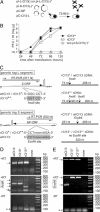Recovery of an arenavirus entirely from RNA polymerase I/II-driven cDNA
- PMID: 16537369
- PMCID: PMC1450228
- DOI: 10.1073/pnas.0600652103
Recovery of an arenavirus entirely from RNA polymerase I/II-driven cDNA
Abstract
The prototypic arenavirus lymphocytic choriomeningitis virus has been a primary workhorse of viral immunologists for almost a century, and it has served as an important model for studying basic principles of arenavirus molecular biology. Its negative-stranded bisegmented RNA genome has, however, posed a major obstacle to attempts at manipulating the infectious virus by reverse genetic techniques. Here, we report the recovery of infectious lymphocytic choriomeningitis virus (the immunosuppressive strain clone 13) entirely from cDNA. Intracellular transcription of the short and the long viral genome segment from polymerase (pol) I-driven vectors and coexpression of the minimal viral-transacting factors NP and L from pol II-driven plasmids resulted in the efficient formation of infectious virus with genetic tags in both genome segments. The cDNA-derived viruses behaved identically to wild-type virus in both cell culture and infected mice. Importantly, they caused a chronic infection and suppressed the adaptive immune response to an unrelated third-party virus. This technology provides an important basis for investigating viral determinants of persistent infection and immunosuppression. In addition, our findings demonstrate that pol I/II-based vector systems may represent an efficient alternative strategy for the recovery of cytoplasmic negative-strand RNA viruses from cDNA.
Conflict of interest statement
Conflict of interest statement: No conflicts declared.
Figures




Similar articles
-
Recovery of infectious foot-and-mouth disease virus from full-length genomic cDNA clones using an RNA polymerase I system.Acta Biochim Biophys Sin (Shanghai). 2009 Dec;41(12):998-1007. doi: 10.1093/abbs/gmp093. Acta Biochim Biophys Sin (Shanghai). 2009. PMID: 20011974
-
Role of the virus nucleoprotein in the regulation of lymphocytic choriomeningitis virus transcription and RNA replication.J Virol. 2003 Mar;77(6):3882-7. doi: 10.1128/jvi.77.6.3882-3887.2003. J Virol. 2003. PMID: 12610166 Free PMC article.
-
Rescue of the prototypic Arenavirus LCMV entirely from plasmid.Virology. 2006 Jul 5;350(2):370-80. doi: 10.1016/j.virol.2006.01.012. Epub 2006 Feb 14. Virology. 2006. PMID: 16476461
-
Reverse genetics systems for the generation of segmented negative-sense RNA viruses entirely from cloned cDNA.Curr Top Microbiol Immunol. 2004;283:43-60. doi: 10.1007/978-3-662-06099-5_2. Curr Top Microbiol Immunol. 2004. PMID: 15298167 Review.
-
[The reverse genetics systems for human and animal RNA viruses].Sheng Wu Gong Cheng Xue Bao. 2004 May;20(3):311-8. Sheng Wu Gong Cheng Xue Bao. 2004. PMID: 15971597 Review. Chinese.
Cited by
-
Development of live-attenuated arenavirus vaccines based on codon deoptimization.J Virol. 2015 Apr;89(7):3523-33. doi: 10.1128/JVI.03401-14. Epub 2015 Jan 14. J Virol. 2015. PMID: 25589652 Free PMC article.
-
Development of a Mini-Replicon-Based Reverse-Genetics System for Rice Stripe Tenuivirus.J Virol. 2021 Jun 24;95(14):e0058921. doi: 10.1128/JVI.00589-21. Epub 2021 Jun 24. J Virol. 2021. PMID: 33952642 Free PMC article.
-
A novel phosphoserine motif in the LCMV matrix protein Z regulates the release of infectious virus and defective interfering particles.J Gen Virol. 2016 Sep;97(9):2084-2089. doi: 10.1099/jgv.0.000550. Epub 2016 Jul 15. J Gen Virol. 2016. PMID: 27421645 Free PMC article.
-
NEDD4 family ubiquitin ligases associate with LCMV Z's PPXY domain and are required for virus budding, but not via direct ubiquitination of Z.PLoS Pathog. 2019 Nov 11;15(11):e1008100. doi: 10.1371/journal.ppat.1008100. eCollection 2019 Nov. PLoS Pathog. 2019. PMID: 31710650 Free PMC article.
-
Identification of amino acid residues critical for the anti-interferon activity of the nucleoprotein of the prototypic arenavirus lymphocytic choriomeningitis virus.J Virol. 2009 Nov;83(21):11330-40. doi: 10.1128/JVI.00763-09. Epub 2009 Aug 26. J Virol. 2009. PMID: 19710144 Free PMC article.
References
-
- Armstrong C., Lillie R. D. Public Health Rep. 1934;49:1019–1027.
-
- Rivers T. M., Scott T. F. M. Science. 1935;81:439–440. - PubMed
-
- Zinkernagel R. M. Curr. Top. Microbiol. Immunol. 2002;263:1–5. - PubMed
-
- Wright R., Johnson D., Neumann M., Ksiazek T. G., Rollin P., Keech R. V., Bonthius D. J., Hitchon P., Grose C. F., Bell W. E., Bale J. F., Jr Pediatrics. 1997;100:E9. - PubMed
-
- Geisbert T. W., Jahrling P. B. Nat. Med. 2004;10:S110–S121. - PubMed
Publication types
MeSH terms
Substances
Associated data
- Actions
- Actions
LinkOut - more resources
Full Text Sources
Other Literature Sources
Molecular Biology Databases
Miscellaneous

